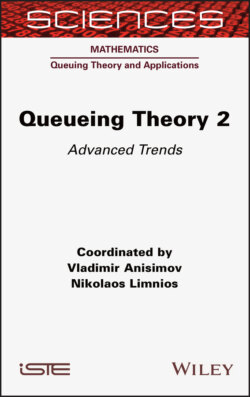Читать книгу Queueing Theory 2 - Nikolaos Limnios - Страница 13
1.2. Model description
ОглавлениеWe begin from the definition of the regenerative flow (Afanasyeva and Bashtova 2014)). Assume a stochastic process {X(t), t ≥ 0} (X(0) = 0) taking values 0, 1, 2... to be defined in a probability space The process has non-decreasing and right-continuous sample paths. There exists filtration exists such that X is measurable with respect to
DEFINITION 1.1.– The stochastic flow X is called regenerative if there is an increasing sequence of Markov moments with respect to such that the sequence
consists of independent identically distributed (iid) random elements on
The random variable is said to be the ith regeneration point of X and is the ith regeneration period Let be the number of customers arrived during the jth regeneration period. Assume that The limit with probability 1 (w.p.1) is called the rate of X. It is easy to prove that (Smith 1955; Thorisson 2000). The class of regenerative flows contains most of fundamental flows that are exploited in the queueing theory. First of all, the doubly stochastic Poisson process (Grandell 1976) with a regenerative process as a stochastic intensity is a regenerative flow. There are many other examples of regenerative flows, for instance, semi-Markovian, Markov-arrival, Markov- modulated and other processes (Afanasyeva and Tkachenko 2012).
We consider discrete-time queueing systems as well as continuous-time queueing systems (Avi-Itzhak and Naor 1963). In the first case, time is divided into fixed length intervals or slots and all arrivals and departures are synchronized with respect to slot boundaries. Moreover, in the case of some events being synchronized at one slot these events are ordered as follows: arrival and departure. The system is observed at the end of the slot.
We consider a queueing system S with m servers, FCFS discipline and regenerative input flow X . We assume that a server may simultaneously serve only one customer so that at any time the number of customers on the servers is not more than m. A customer leaves a system only after completion the service. The system is defined by the sequence consisting of iid random vectors and multidimensional stochastic process which are independent of the input flow X. The vector determines the characteristics of the nth customer, that is service times by various servers or necessary number of servers for service. The process V describes the states of the servers. For example, for the systems with unreliable servers this process defines the moments of breakdowns and restorations of the servers. The state of the system at time t is described by the stochastic process where one of the coordinates is the number of customers in the system. We assume that the relation
[1.1]
takes place for some function Φ(∙) on the corresponding space. For example, for the system Reg|G|1|∞ we consider the process where W(t) is the virtual waiting time and Q(t) is the number of customers in the system at time t. Let be the sequences of service and arrival times of customers, respectively, and Assuming that Q(0) = 0, we have W(t) = where is an indicator function (Borovkov 1976).
The main goal of this chapter is the determination of the conditions of the stochastic boundedness of the number of customers Q(t) in the system as t → ∞. Our analysis is based on the construction of the auxiliary service process.
